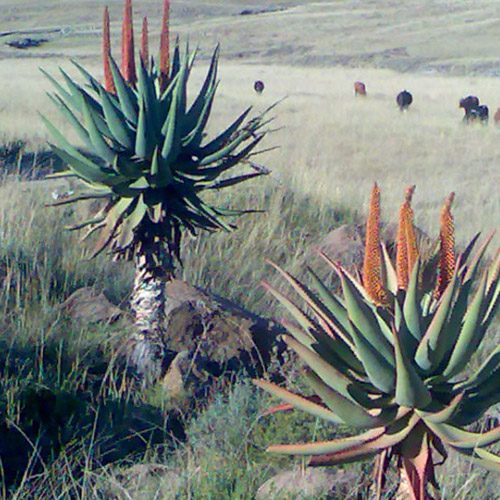📷 Gregorydavid, wikipedia.org
Aloe ferox aka Cape Aloe
Aloe | Updated: February 15, 2025
This beautiful, large Aloe has long green leaves that turn red in full Summer sun. The edges of the leaves have teeth, and the leaves curl upright. Tall spikes with orange flowers can appear on mature plants in the Fall.
Quick Guide
- Full sun to partial shade 🌤️
- Typical water needs for a succulent
- Plant grows up to 24″ (60 cm) tall
- Plant grows up to 36″ (91 cm) wide
- Zone 9a (Minimum 20° F | -6.7° C)
- Not cold hardy
- Propagation by offsets and seeds
- Spines can cause irritation to pets and people
- Summer Dormant
How to 🩷 Care for and Propagate Your 🪴 Succulents
General Care for Aloe ferox aka Cape Aloe
Aloe ferox, commonly known as Cape Aloe, is a striking addition to rock gardens or xeriscaped yards. Its vibrant flowers are a magnet for bees and hummingbirds. Keep in mind, though, that the leaves of young plants are quite fragile and can break off easily.
Watering
Cape Aloe has the typical watering needs of a succulent. The soak and dry method is ideal, allowing the soil to dry out completely between waterings.
Where to Plant
Aloe ferox isn’t cold-hardy, so if your area gets colder than 20°F (-6.7°C), it’s best to plant this succulent in a container you can bring indoors. It thrives in full to partial sun, needing about 6 hours of sunlight daily. Indoors, place it near a south-facing window for optimal sunlight (if you’re in the Northern Hemisphere).
How to Propagate Aloe ferox aka Cape Aloe
Propagation can be done through offsets or seeds.
Offsets
To propagate from offsets, use a sterile, sharp knife or scissors to remove a stem from the main plant. Let the offset callous for several days before planting it in well-draining soil. Water only when the soil has dried out completely.
Seeds
To grow Cape Aloe from seeds, sow them in well-draining soil. If you live in a zone above 9a, you can grow them outdoors. In cooler areas, start sowing indoors under a grow light or on a seed mat.



